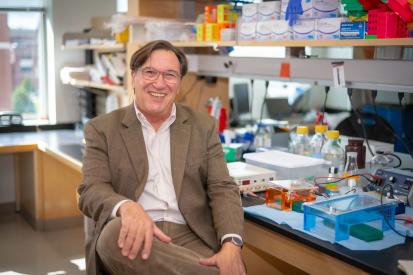
Micronutrient transition metals (copper, zinc, cobalt, nickel, iron, and manganese) play a central role in the interaction of pathogenic (and beneficial) bacteria with higher eukaryote hosts. Our research is directed to understand the bacterial mechanisms of metal homeostasis required for these interactions. In particular, we focus on the functions of transmembrane transporters and chaperone molecules that tightly control metal uptake and distribution. These molecules appear to be key determinants of virulence in pathological bacteria like Mycobacterium tuberculosis and Pseudomonas aeruginosa, or symbionts such as Rhizobium meliloti. In addition, we study the molecular structure and biochemical mechanisms of metal selectivity in transmembrane transport ATPases. Our multidisciplinary approaches include structural and molecular biology, enzymology, biophysics, protein chemistry, fluorescence microscopy, and microbiology. Through a number of ongoing collaborations, we also employ crystallography, X-ray fluorescence and spectroscopy, and bioinformatics to gain insights into the role of metals in bacterial virulence. Collaboration and camaraderie among postdoctoral fellows, graduate students, and undergraduate students are hallmarks of our work. I enjoy mentoring these young colleagues and guiding their progress into a scientific career.

Micronutrient transition metals (copper, zinc, cobalt, nickel, iron, and manganese) play a central role in the interaction of pathogenic (and beneficial) bacteria with higher eukaryote hosts. Our research is directed to understand the bacterial mechanisms of metal homeostasis required for these interactions. In particular, we focus on the functions of transmembrane transporters and chaperone molecules that tightly control metal uptake and distribution. These molecules appear to be key determinants of virulence in pathological bacteria like Mycobacterium tuberculosis and Pseudomonas aeruginosa, or symbionts such as Rhizobium meliloti. In addition, we study the molecular structure and biochemical mechanisms of metal selectivity in transmembrane transport ATPases. Our multidisciplinary approaches include structural and molecular biology, enzymology, biophysics, protein chemistry, fluorescence microscopy, and microbiology. Through a number of ongoing collaborations, we also employ crystallography, X-ray fluorescence and spectroscopy, and bioinformatics to gain insights into the role of metals in bacterial virulence. Collaboration and camaraderie among postdoctoral fellows, graduate students, and undergraduate students are hallmarks of our work. I enjoy mentoring these young colleagues and guiding their progress into a scientific career.
Scholarly Work
Novoa-Aponte, L., Xu, C., Soncini, F.C. and Argüello, J.M. (2020) The two-component system CopRS maintains subfemtomolar levels of free copper in the periplasm of Pseudomonas aeruginosa using a phosphatase-based mechanism. mSphere 5:e01193-20
Quintana, J., Novoa-Aponte, L., and Argüello J.M., Copper Homeostasis Networks in the bacterium Pseudomonas aeruginosa. (2017) Journal of Biological Chemistry 292: 15691-15704.
Blaby-Haas, C.E., Padilla-Benavides, T., Stübe1, R. Argüello, J.M. and Merchant, S.S. (2014) Evolution of a plant-specific copper chaperone family for chloroplast copper homeostasis. Proceedings of the National Academy of Sciences-USA 111:E5480-E5487
González-Guerrero, M. and Argüello, J.M. (2008) Mechanism of Cu+ transporting ATPases: Soluble Cu+-chaperones directly transfer Cu+ to transmembrane transport sites. Proceedings of the National Academy of Sciences-USA 105, 5992 - 5997
Fulbright Association
American Association for the Advancement of Science
Journal of Biological Chemistry
WPI Board of Trustees
Sigma Xi - WPI Chapter
Sigma Xi - WPI Chapter
National Institutes of Health
